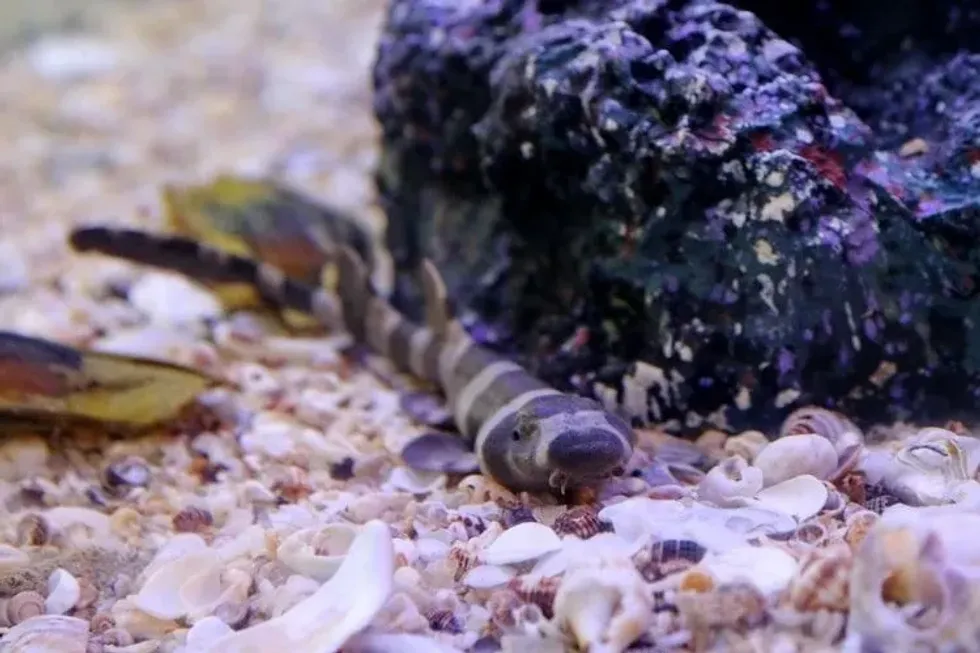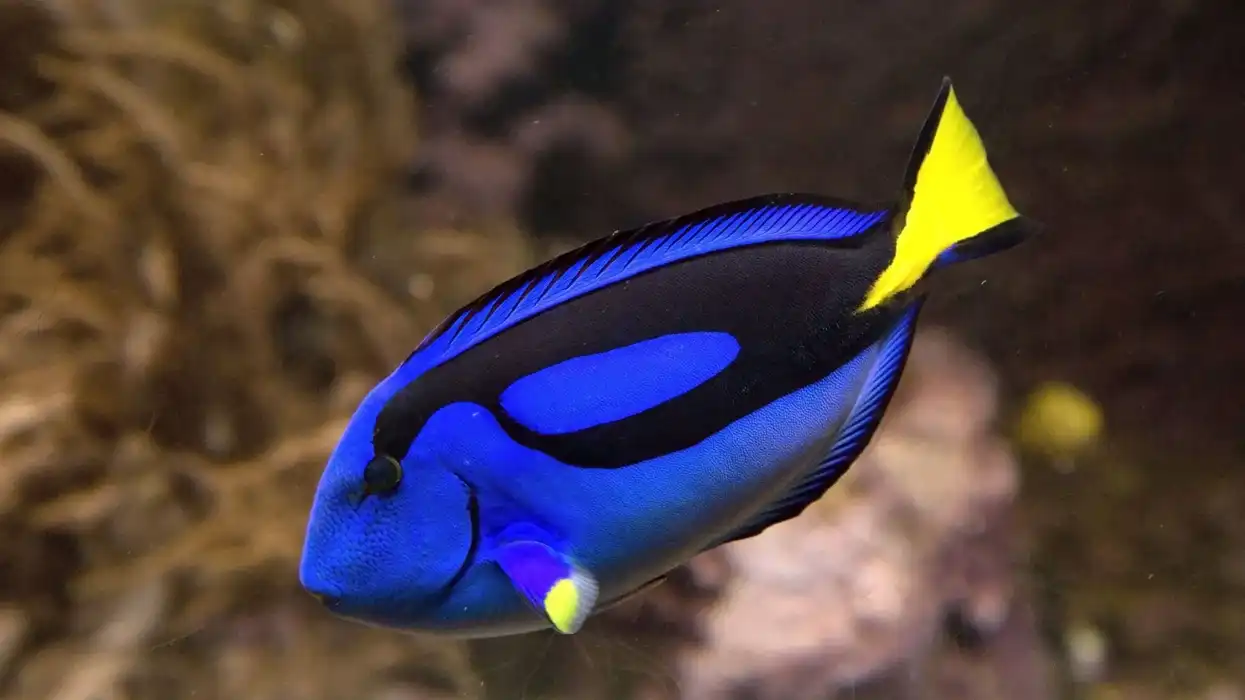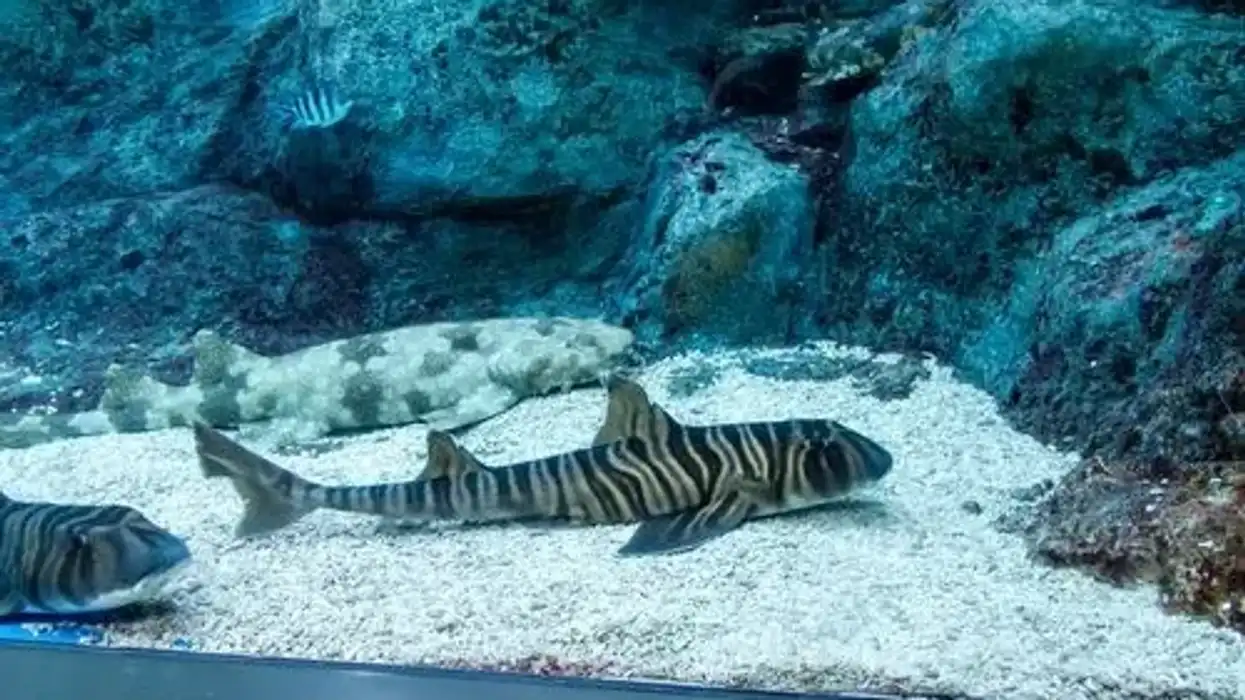Do you have any idea what the other name of this interesting aquatic creature is? The brownbanded bamboo shark is commonly known as a gray carpet shark due to its resemblance with an intricate texture of a carpet.
The Indo-West Pacific Ocean's tide pools and coral reefs are home to these brown-banded bamboo sharks which can be found off the shores of India, Malaysia, Thailand, Singapore, China, Japan, and the Philippines. They are also found on the coast of New Guinea and Northern Australia.
This species has brown bands throughout their slender, pale brown body with a long and broad tail. Another name of this creature is cat shark because it has sensory organs, also known as barbels, that look like whiskers.
They help this species to find their food. They are carnivores and solely feed on small fishes and other marine animals like crab, worm, shrimp, and squid. These nocturnal species live on the muddy seafloor and rarely swim to the surface.
Unfortunately, nowadays, these beautiful species are listed as Near Threatened by the International Union for Conservation of Nature (IUCN) Red List due to their rapidly declining numbers. To read and learn more about this unique creature, keep reading the article.
If you like reading this article, do check out our other articles on blind shark and basking shark.
Brownbanded Bamboo Shark Interesting Facts
What type of animal is a brownbanded bamboo shark?
The brown-banded bamboo shark (Chiloscyllium punctatum) is a cartilaginous fish that belongs to the order Orectolobiformes.
What class of animal does a brownbanded bamboo shark belong to?
Brownbanded bamboo sharks are animals that belong to the Chondrichthyes class. These sharks are commonly known as gray carpet sharks.
How many brownbanded bamboo sharks are there in the world?
The information about the number of brownbanded bamboo sharks in the world is still unknown. However, the number of these species is rapidly declining as a result of some major threats faced by them in their home.
These sharks are regularly killed for human consumption and their habitat is being destroyed thanks to fishing and pollution. Apart from pollution and hunting, they are an important element of the aquarium trade in various marketplaces since they are one of the few shark species capable of surviving in an aquarium.
Where does a brownbanded bamboo shark live?
Brown-banded bamboo sharks can be found off the coasts of India, Malaysia, Thailand, Singapore, China, Japan, and the Philippines in the Indo-West Pacific Ocean. They are also found in the waters along the coasts of New Guinea and Northern Australia.
What is a brownbanded bamboo shark's habitat?
The brownbanded bamboo shark habitat is in the tide pools and coral reefs of tropical warm waters of the Indo-Pacific Ocean. These sharks like to dwell on the muddy sea bed 278.8 ft (85 m) below the sea, and mostly avoid coming up to the surface.
A young brown-banded bamboo shark has dark transverse bands on its body which helps it to remain camouflaged amidst the corners of the reefs. These species are nocturnal in nature and cannot survive the light.
Who do brownbanded bamboo sharks live with?
These species are solitary in nature, but the adults are known to come together during the time of reproduction.
How long does a brownbanded bamboo shark live?
Brownbanded bamboo sharks are quite docile in nature and thrive well in aquariums. In captivity, these sharks have a lifespan of about 25 years.
How do they reproduce?
Brownbanded bamboo sharks, also known as a cat sharks, are oviparous. This means that females lay eggs, and the pup develops within the egg.
However, unlike other ovoviviparous sharks, reproduction does not happen inside the female shark. The eggs are long and flat in nature, and the embryos get all the nutrients from the yolk inside till they hatch and become independent.
It takes about approximately four months for the eggs to hatch in an aquarium once they emerge from the females. A baby shark's length is around 6-7 in (15.2-17.7 cm).
What is their conservation status?
According to the International Union for Conservation of Nature (IUCN) Red List, brownbanded bamboo sharks are Near Threatened. Human consumption, the aquarium trade, water pollution, and hunting are the major threats that this species regularly face.
Brownbanded Bamboo Shark Fun Facts
What do brownbanded bamboo sharks look like?
A brownbanded bamboo shark has brown bands throughout its slender, pale brown body, thus justifying its name. Its long and broad tail and its oversized eyes are the most distinguishing features of this marine animal.
They have sensory organs, often known as barbels which help them to find their food. These sensory organs look like whiskers, and hence these sharks are commonly known as 'cat sharks'.
A young brownbanded bamboo shark has deeper bands and dark spots scattered all over its body which fades as it turns into an adult.
They have two similar-sized, thin dorsal fins with no spine, straight pectoral fins with a wide tip, a long anal fin, and an asymmetrical caudal fin.
The dorsal fin and the anal fin are situated at the posterior portion of the body of these sharks. These fins (dorsal fin and anal fin) assist these sharks in effectively crawling across rugged seabeds and coral reefs for food.

How cute are they?
These sharks are small in size and are slow-moving, and totally harmless to humans. Many people may find this shark to be adorable and social due to its gentle nature, in contrast to the more dangerous shark species.
How do they communicate?
Since this is a largely solitary species, little information about their communication is known.
How big is a brownbanded bamboo shark?
These animals are small in size in contrast to the rest of the massive sharks. The brownbanded bamboo shark size is no more than 3 ft (91.4 cm), which is almost four times the size of a dwarf lanternshark.
How fast can a brownbanded bamboo shark swim?
Although there isn't enough information on the speed of these marine animals, it is known that they are slow-moving sharks.
How much does a brownbanded bamboo shark weigh?
A brownbanded bamboo shark weighs around 132 lb (59.8 kg).
What are the male and female names of the species?
Male and female brown-banded bamboo sharks have no distinct names. They are just simply referred to as or called a male brown-banded bamboo shark and a female brown-banded bamboo shark.
What would you call a baby brownbanded bamboo shark?
A young brownbanded bamboo shark is known as a pup.
What do they eat?
Brownbanded bamboo sharks are carnivores who feed on small fishes and other marine animals like crab, worm, shrimp, and squid. These nocturnal hunters will hide in coral reefs and muddy bottoms and will scavenge for food underneath the sea bed at night.
If they are kept in an aquarium or enclosure, they need feeding two to three times a week with their favorite food including fresh squid, shrimp, and other small marine fish. Since they are in a foreign aquarium, these sharks should also be given some iodine supplements to avoid any kind of goiter disease.
Are they dangerous?
No, these creatures do not pose a threat to humans. They can snap at divers only if they feel threatened, although they are mostly peaceful marine animals.
Would they make a good pet?
Yes, cat sharks are remarkable pets due to their gentle nature and small size.
Since they are a small species of shark with a length of around 3 ft (91.4 cm), they may be kept in a big 180 gal (818.2 L) tank. Many aquarium enthusiasts may want to keep one as a pet because of how these sharks thrive in captivity.
They can thrive well in a tank with other aquatic animals like eels, snappers, large angelfish, parrotfish but will not be happy if you introduce a pufferfish or a triggerfish.
Did you know...
A fascinating feature about this shark is its teeth. Their tiny teeth are capable of crushing delicate prey. On the other hand, when they wish to consume hard-shelled prey, their teeth may move backward, protecting the tip of the teeth and creating a powerful and flat surface to chomp on the shells efficiently.
Due to its small mouth, this creature often spits out larger prey that it cannot chew, and therefore it should feed only on small aquatic animals.
These sharks can survive for up to 12 hours out of the water.
Although it is unknown how many eggs these sharks lay in the wild, they do lay more eggs in an aquarium. There is a record of three females of these species laying 466 eggs in an aquarium in Thailand and six females laying 692 eggs in an aquarium in Australia.
How did brownbanded bamboo sharks get their name?
Brown bands cover the light brown bodies of the adults, which are darker in juveniles. This is how a brownbanded bamboo shark received its distinct name. They are also called gray carpet sharks since these marine animals are sea-bottom dwellers and have a neat and intricately designed body that resembles a well-designed carpet.
Are brownbanded bamboo sharks endangered?
Yes, these marine animals are endangered. They are categorized as Near Threatened according to the International Union for Conservation of Nature (IUCN) Red List because of their decline in numbers.
These sharks are frequently killed for human consumption, habitat devastation, and water pollution. Humans also widely capture them for trade as these are one of the few shark species that can survive in an aquarium.
Here at Kidadl, we have carefully created lots of interesting family-friendly animal facts for everyone to discover! For more relatable content, check out these reef shark facts and blacktip shark facts for kids.
You can even occupy yourself at home by coloring in one of our free printable Brownbanded bamboo shark coloring pages.










